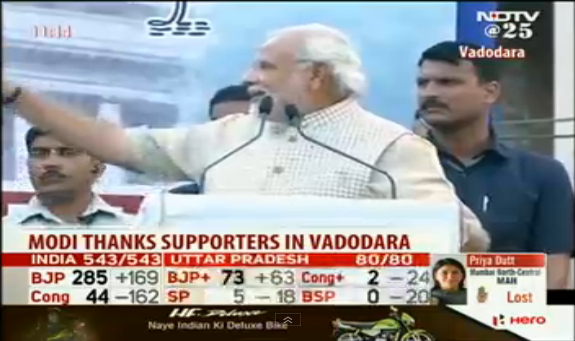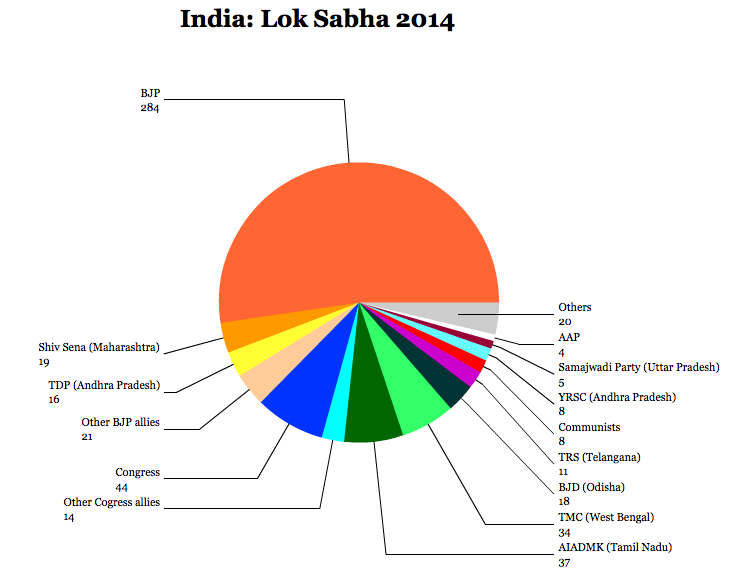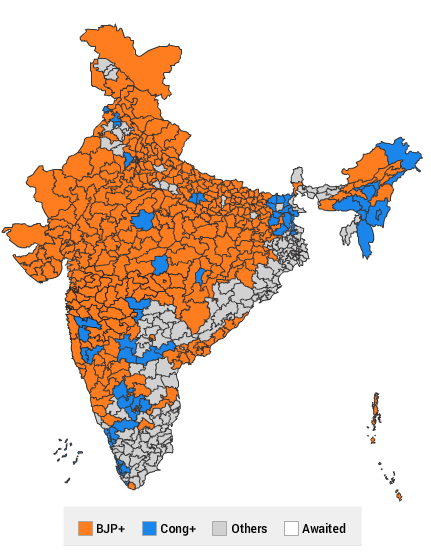The results are now (largely) in for what will certainly be one of the biggest election dramas of the decade.![]()
Narendra Modi, Gujarat’s chief minister, has led the Hindu nationalist Bharatiya Janata Party (the BJP, भारतीय जनता पार्टी) to its best-ever victory. In India’s post-independence history, it’s the first time that the BJP — or any party — has won an absolute majority other than the Indian National Congress (Congress, भारतीय राष्ट्रीय कांग्रेस).
* * * * *
RELATED: In-Depth: India’s elections
* * * * *
Conversely, the Congress, the party of Indian independence and the party of Mahatma Gandhi and Jawaharlal Nehru, has suffered its worst defeat in the history of independent India. After a decade of rule, party president Sonia Gandhi and her son, party vice president Rahul Gandhi, face a long wilderness in the Modi era.
Here’s the latest on results, via NDTV:
The BJP, by itself, will hold 284 seats, which gives it an absolute majority in the Lok Sabha (लोक सभा). Together with its allies in the National Democratic Alliance (NDA), it will hold 340 seats. That represents the largest mandate that any governing coalition has won since 1984, when Congress won over 400 seats under Rajiv Gandhi, who was waging the fight after his mother, Indira Gandhi, was assassinated by her SIkh bodyguards in the wake of Sikh riots.
It’s hard to describe just what a massive landslide this was, but this NDTV map of all 543 constituencies give you a good idea:
In terms of the vote totals, the BJP has won around 31.1% of the vote, while Congress won just 19.4% of the vote.
Ironically, the Bahujan Samaj Party (BSP, बहुजन समाज पार्टी) of former Uttar Pradesh chief minister Mayawati, won the third-largest share of the vote, 4.2%, though the BSP won no seats.
Everyone was expecting the BJP to win this election, yes, and everyone was expecting Modi to become India’s next prime minister. But the high end of the estimates, even from the exit polls that in 2004 and 2009, overestimated the BJP’s support, was around 300 seats total. Even going into today’s announcement of the results, no one was entirely sure if the NDA would win an absolute majority.
No one thought the BJP — by itself — would win an absolute majority. In 1999, the previous high-water mark for the BJP, which led to an NDA-led coalition government for the following five years, the coalition won just 270 seats, and the BJP won 182 seats.
Today’s results mean that the BJP has not only won its best-ever victory, it will top its previous best by a margin of 102 seats. That’s incredible, and the closest analog I can think of in world politics is the 1997 election in the United Kingdom, which ushered the Labour Party into power for the next 13 years.
So what will Modi do with this mandate?
He’s run a presidential-style campaign, attacking Congress’s record on corruption and economic mismanagement, and he pledges to bring to the entire country the model of economic stewardship from his home state of Gujarat, where he’s served as chief minister for the past 13 years.
* * * * *
RELATED: What exactly in the Gujarat model? And can Modi exert it nationally?
* * * * *
The international community certainly expects Modi to implement wide-ranging reforms to open India’s markets to greater competition and further liberalize its economy. Though Modi hasn’t outlined the specifics of his expected reform program, and while there’s certainly a protectionist element in the BJP, meaning that economic reforms aren’t expected to be easy or automatic, the ‘Modi wave’ gives India the best chance in nearly a quarter-century to accomplish those reforms.
He’ll pick up where Manmohan Singh left off with the liberalization reforms that he implemented as finance minister in 1991. Ironically, however, Modi has been elected largely to carry out the next stage of economic reform that Singh couldn’t enact in his decade as prime minister since 2004.
So where does the Congress go from here? It may not even have enough seats (54) to become the formal opposition under Lok Sabha procedure. Though it’s too early to know whether the defeat will spell the end of the Nehru-Gandhi family, it certainly seems like the party is due for a spell of soul-searching. In Uttar Pradesh, India’s most populous state, the only two seats that Congress won were Sonia Gandhi’s in Rae Bareli and Rahul Gandhi’s in Amethi (and that came only after an early scare, when the first results showed Rahul Gandhi trailing the BJP candidate).
Though India’s regional parties have grown over the past decade, and they have generally started crowding out both the BJP and the Congress, it was a mixed result. In Uttar Pradesh, the governing the Samajwadi Party (समाजवादी पार्टी, Socialist Party) appears to have won just five seats out of 80.
But in Tamil Nadu, the governing Dravidian party of chief minister Jayalalithaa, the AIADMK, has won 37 out of 39 seats. In West Bengal, chief minister Mamata Banerjee’s All India Trinamool Congess (TMC, সর্বভারতীয় তৃণমূল কংগ্রেস) won 34 out of 42 seats.
Supporters of Arvind Kejriwal’s anti-corruption Aam Aadmi Party (AAP, आम आदमी की पार्टी, Common Man Party) might, at first glance, be disappointed. Kejriwal, who challenged Modi directly in the Uttar Pradesh constituency of Varanasi, won just 21.34% of the vote there. In Delhi, where the AAP swept to power after the legislative assembly elections in December 2013, it won no seats. The result is obviously not the best news for Kejriwal, who resigned as Delhi’s chief minister after just 49 days when his opponents refused to pass an anti-corruption bill that he’d pledged to enact. Both Kejriwal’s hasty resignation as chief minister in February and his decision to wage a large-scale national campaign both seem like strategic mistakes.
But there’s a silver lining for the AAP. It’s just a new party and, because it’s a national party, its supporters are dispersed throughout the country. The first-past-the-post system gives an advantage to regional, state-based parties, whose strength can be concentrated in a handful of constituencies. Nonetheless, the AAP will have won around 2.1% of the national vote, and it made some breakthroughs in Punjab state, where it unexpectedly won all of its four Lok Sabha seats. Moreover, even in Delhi, where it won 29.5% of the vote in the local elections in December, it increased its support to around 32%, giving it some hope that its local Delhi-centric base hasn’t yet abandoned it.
The West Bengal-based TMC finished fourth place nationally with 4.2% of the vote, followed by the Uttar Pradesh-based SP with 3.4%, the Tamil Nadu-based AIADMK with 3.3% and the Communist Party of India (Marxist) (CPM, भारत की कम्युनिस्ट पार्टी (मार्क्सवादी)), which has a strong following in Kerala and West Bengal, with 3.3%.



CircularSquareFebruary 14, 2013 Don’t pay too much attention to Ramchandra Guha. He is what is known as Apologist. Even if he wants to priase Narendra Modi he will do so with apprehensions because of fear of offending the so-called liberals. To his credit he considered Rahul baba is unsuitable too. But that was only an aside.When BJP first came to power liberal media predicted that India would become like Nazi Germany. Did anything like that happen? I am not a big fan of BJP but I am a fan of change. And we need a change from the UPA.
PM Modi has the sentiments of all of the right wing Hindu population. This mandate is indeed one of the largest!